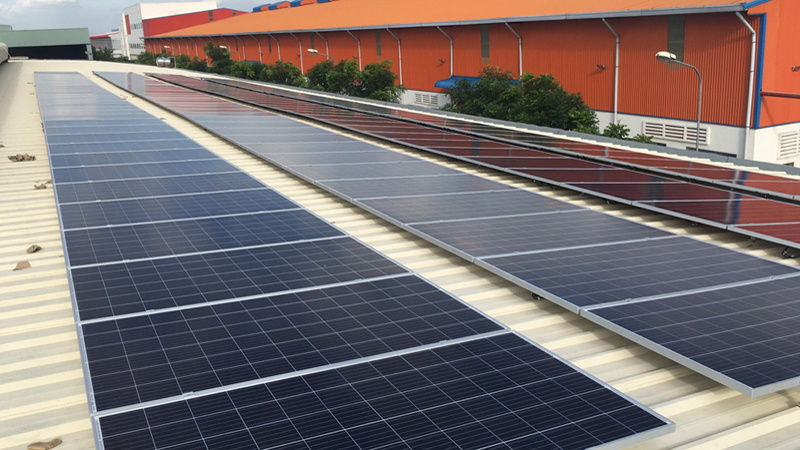Green,Innovation,Intelligent, Sharing
2022-07-25
The next step in the energy revolution, why must it be solar energy?
The past 100 years has been the 100th year of "easy energy" - that is, it is easy to explore, mine and utilize these mineral energy sources with technology because they do not require much advanced innovation. However, the earth's resources are limited, and by 2030 people's demand for energy will increase two to three times. But whether from a climate perspective or energy extraction, the plight of traditional energy cannot be ignored.
Oil, gas and coal are non-renewable energy sources, they are reliable but expensive, and human society needs a new energy plan. To meet the population and productivity demands of the global economy - economic growth needs energy to support it. And renewing the energy we need at the source to harmonize it with living systems, such as solar and wind energy and others mentioned, is an expression of future wisdom in the energy field.
The changing energy landscape
In fact, human civilization has not been wise enough in the use of energy and has no regard for the future. For thousands of years, humans have extracted energy from the land or ocean, destroyed landscapes to grab coal, and burned oil to power our cars and cities, and in the process, have caused climate change, pollution.
All the while, the energy that people use, mainly fossil fuels, has become increasingly scarce, expensive, and has an impact on the climate to a level that threatens human existence.
As for how to change this bad situation, it seems the easiest answer is to stop burning fossil fuels, but it is very difficult to do so. Fossil fuel has been equated with modern people's life, and it is indeed "fueling" modern people's life. Another approach is to run the energy system in a "smarter" way. Most energy systems operate on the basis that energy supply follows energy demand and maintains a stable balance between supply and demand, especially electricity.
However, in order to truly solve the energy crisis, the most important thing is to find alternative energy sources for fossil fuels. For electricity generation, we can replace fossil fuels with low-carbon energy sources such as renewables, wind, solar and biomass, and of course, nuclear. The development of new energy sources that can replace fossil fuels is also a trend in the energy field in recent years.
An example of this is the international initiative "RE100", which has been promoted since 2014. RE100, short for "100% Renewable Energy", is an initiative led by the global non-profit organization "The Climate Group" and the global environmental management certification body "Carbon Disclosure Project" (Carbon Disclosure Project). Previously, 100% of the electricity used by enterprises was converted into the use of renewable energy.
Of course, this process involves various interests. In order to grasp the hegemony of the new and renewable energy era, the battle between countries and the strategies of major companies are changing all the time. But there is no doubt that if mankind does not achieve carbon neutrality and the conversion of renewable energy, it will eventually face an energy catastrophe. In other words, switching to renewable energy is still the primary issue facing mankind.
In 2017, Professor Mark Jacobson of Stanford University proposed a blueprint to promote 100% renewable energy use by 2050 in 139 countries, including the United States. He used computer modeling to prove that renewable energy generation is superior to traditional energy generation, and the secret lies in the way electricity is stored. If electricity storage, heat storage, low temperature energy storage, hydrogen storage equipment and renewable energy power generation equipment are combined, all electricity can be supplied with clean renewable energy.
Among the sustainable development goals proposed by the United Nations from 2016 to 2030, the seventh goal is to use renewable resources and energy. Bloomberg New Energy Finance's New Energy Outlook 2020 (NEO2020) predicts that 80% of the $15 trillion that will be invested in new power generation equipment over the next three decades will be in solar, wind, and energy storage systems (ESS). ) and other new and renewable energy sources. In addition, by 2050, new and renewable energy sources will provide 56% of the world's electricity.
Professor Tony Seba wrote in "Energy Revolution 2030", "The Stone Age will end, not because man runs out of stones, but because better technology 'bronze' has replaced stone tools", and today's energy status is also in this way. In addition to whether fossil fuels are depleted, global energy resources are bound to change as the cost of generating electricity from renewable energy gradually declines with the development of advanced technologies.
The main force of energy transformation
Among the new renewable energy sources, the most worthy of attention is "solar energy".
For thousands of years, human civilization has been eager to use the sun, an inexhaustible fireball. To get rid of fossil fuels, the world also needs to harness more solar energy. Our star produces 2 billion times the energy of the beam (sunlight) that eventually reaches Earth. However, those beams provide more than 10,000 times the energy the world needs. This means that, in theory, for the United States, solar panels covering just 1% of Texas could meet all of the nation's electricity needs. In other words, the sun can increase the world's energy by thousands of times.
In fact, the solar market has grown by more than 40% almost every year since 2000. If this trend continues, solar energy could soon account for 100% of global energy production. The continued growth of solar energy will eventually replace the market share of fossil fuels.
If China and the United States maintain stable demand and developing countries restart solar energy plans that have been delayed due to the new crown epidemic, the global photovoltaic installations in 2021 will increase by more than 20% from the previous year. Bloomberg New Energy Finance estimates that the global solar photovoltaic installations in 2021 will be 151 GW to 194 GW. If the installed capacity reaches 194 GW, it is expected to grow by more than 45% from the previous year.
South Korea will also promote solar power generation from a large-scale plan in Saemangeum. In order to become a carbon neutral country, South Korea will set specific goals and put them into action. Its solar energy market will gradually expand. In 2020, South Korea's solar market was only 3.8 GW, but will grow to more than 4 GW in 2021.
If the global economy can stabilize, there could be up to 200 GW of solar demand in 2022. This is the first time in five years that demand has nearly tripled compared to 2017.
Currently, solar energy provides 1/3 of the world's electrical energy. By the end of the 21st century, converting sunlight into electricity, heat and portable fuels could meet most of the world's energy needs. By then, the 21st century will be remembered in history as the era when humanity finally tamed the sun.
And, the solar technology of the future will also be different from the current silicon-based solar photovoltaic panels. It is undeniable that these photovoltaic panels have indeed played an important role in establishing solar energy technology as a viable energy source today, and their success has also convinced investors around the world that it is safe to invest in clean energy projects. At present, these photovoltaic panels are gradually evolving from the initial bulky, crude appearance and extremely poor performance to today's lightweight, novel and beautiful, and have higher photoelectric conversion efficiency. By 2030, industrial printers will begin mass-producing solar photovoltaic coatings in a variety of colors and different transparencies. In 10 years, coating people's houses with solar power may be as cheap as painting them.
While solar energy has become the protagonist of the energy revolution, the stage still needs supporting actors. In the 21st century, wind energy has shown a steady upward trend, becoming a powerful complement to solar energy. In the past decade, wind power has driven the development of the marine renewable energy field, and wind energy is therefore regarded as one of the important transformative factors of the energy landscape. In addition, as major companies strengthen ESG management, which has recently become a hot topic, wind energy is also considered to be the main energy source for green hydrogen production, attracting attention. Green hydrogen is the energy generated by using wind energy to electrolyze water.
In 2020, global wind power installations increased by 59.2% from the previous year, reaching an all-time high of 96.8 GW. Although at that time, the demand for wind power generation was expected to decline due to the impact of the new crown epidemic, the installed capacity of wind power generation in China, which accounted for 60% of global demand, increased by 93.3% compared with the previous year, resulting in a significant increase in global wind power installations.
Compared with onshore wind power, the installed capacity of offshore wind power is still insufficient, and the cost of power generation and installation is relatively high, so it is still in the early stage of the market. In addition, China and the United States accounted for 82.4% of global installations, while wind power installations were concentrated in some regions. And, in the long run, the demand for wind power will continue to increase. Bloomberg New Energy Finance predicts that the global offshore wind market will also expand from 29.1 GW in 2019 to 177 GW in 2030.
The most abundant source of energy on earth
In the context of energy change, if we want to completely get rid of fossil fuels, the first step is to increase the direct use of solar energy, that is, to increase the power generation of solar energy.
Scientists studying potential ways to limit climate change also agree that carbon emissions from the power sector must be reduced by 80 to 100 percent by the middle of the 21st century. This goal has been dubbed the "deep decarbonization" of the power sector. Taking into account economic and political factors, renewable solar and wind energy is clearly the core option to accomplish this task.
There are of course other reasons for decarbonizing the power sector. On the one hand, economic sources of clean electricity already exist, but it is extremely difficult to replace the fossil fuels that underpin other industries. In the industrial sector, for example, there are very limited alternatives to coal and natural gas that heat factories and refineries, while at the same time being affordable. In the field of transportation, petroleum products occupy the core position and dominate the energy consumption of various travel vehicles with more than 90% share. Few alternative fuels in these areas are commercially viable.
The electric vehicle industry is small but has continued to grow, suggesting that electricity may be a viable alternative fuel for the transportation industry. Therefore, decarbonizing electricity is not only the easiest way to start reducing global energy emissions, but it may also be a way to reduce emissions from other sectors that use non-electricity.
On the other hand, in the future, the demand for electricity will also grow rapidly. Today, electricity is being used around the world for projects that have historically relied on other energy carriers.
For example, electric motors have replaced petroleum fuels in driving vehicles; electric heat pumps have replaced natural gas for heating homes and businesses; and in steel production, electric arc furnaces have replaced coal used in steel production. In addition, population growth and urbanization will lead to more people needing access to modern energy. The International Energy Agency predicts that electricity demand could double by the mid-21st century. Even in the best-case scenario, where the world dramatically improves energy efficiency, electricity demand would increase by 80 percent.
By 2050, the world's growing electricity demand will require all or almost all of zero-carbon energy. Among them, the amount of energy provided by solar energy is very critical. Of course, no matter how much of the world's electricity supply can be met by solar energy by the middle of the 21st century, it is an obvious fact that the ultimate potential of solar energy to meet human energy needs cannot be underestimated, as it is the most abundant energy source on earth.
When we predict the technical potential of solar energy, or how much sunlight can be converted into energy, we can have more than 100 different predictions, influenced by environmental, geographic, and technological constraints. But even so, solar energy is unique in its technical capacity to supply the electricity the world needs.
Therefore, in the second half of the 21st century, the most reasonable goal is to make solar energy the world's main energy source, meeting most of the world's energy needs. Getting there will require more than just solar photovoltaic panels that convert sunlight into energy, but also ways to convert sunlight into portable fuel and heat. In addition, achieving this goal will require redesigning the energy system to connect solar energy to the world's energy needs.
Achieving this vision may sound distant and daunting, but Musk is confident the world will achieve it. He predicts: "The main way of producing energy will be solar energy. At least solar energy will occupy a relatively high proportion, maybe slightly more than 50% in the long run."
Related News

Contact Information
 sales@esolarstar.com
sales@esolarstar.com
 0086-13929199660
0086-13929199660
 www.hengzhouenergy.com
www.hengzhouenergy.com
 No. 105, building 10, Hekou Wenta Road, southwest Street, Sanshui District, Foshan
No. 105, building 10, Hekou Wenta Road, southwest Street, Sanshui District, Foshan
Copyright © 2022 Guangdong Hengzhou Energy Technology Co., Ltd All Rights Reserved. Powered by:www.300.cn SEO

 Language
Language 







 sales@esolarstar.com
sales@esolarstar.com

 Whatsapp
Whatsapp
 Message
Message